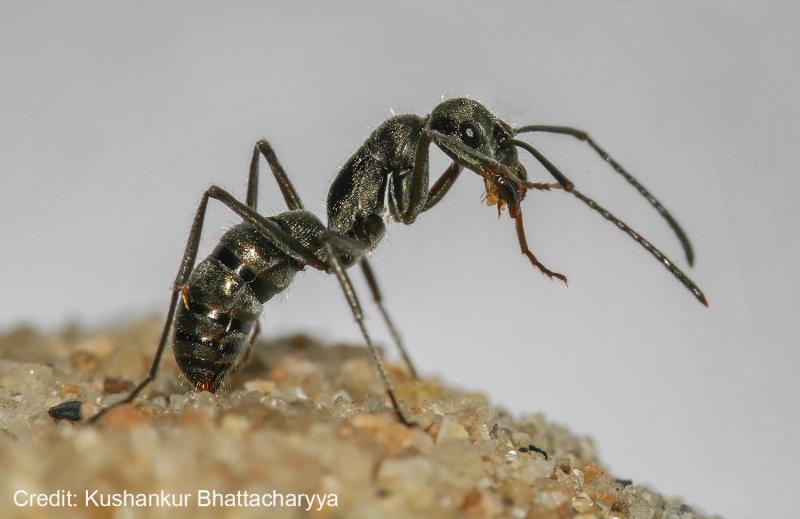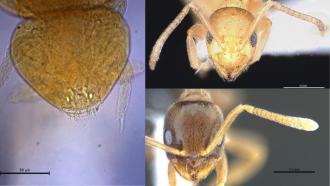
Humans have always been fascinated to see animal nests. Though a weaver bird has never attended a design school, the male weaves an intricate cosy nest to bring home his partner. Termites, without lessons in engineering, build tall mounds out of the mud and make their own ‘concrete’ with their saliva. Ants, who run about busily with crumbs in their mouths also have impressive nests that they build. Although nests provide space for shelter, storage, breeding and protection from predators, they are extensive examples for understanding the social behaviour of many species. For instance, sick ants avoid coming back to their nests to prevent their infection spread to the other members of their colony. In a recent study, researchers from the Indian Institute of Science and Education Research, Kolkata, have investigated the nest architecture of a species of Indian ant, called Diacamma indicum.
Diacamma indicum is found across India, Sri Lanka and Japan and are known to live in colonies consisting of hundreds of ants. They are scavengers, feeding on dead insects, hunting termites and having an immense ecological role in nutrient recycling. Though they are commonly seen species, their nesting behaviour has not been studied yet. In the current study, published in the Journal of Insect Science, the researchers try to understand the unique features of the nests of the Indian queenless ants.

Nests of Diacamma indicum [Image credits: Ant Lab, IISER Kolkata]
“To the best of our knowledge, no other Indian ants’ nest structure has been worked out in detail,” says Prof Sumana Annagiri. She is the principal investigator of the Ant Lab at IISER Kolkata. In her studies spanning more than a decade, she has extensively worked on understanding the behaviour of Diacamma indicum. “We are the first to understand the role of seasonal variations in nest entrance architecture,” she proudly says.
The current research was carried out by her doctoral researcher Kushankur Bhattacharyya. The researchers filled up ant nests in and around IISER campus with molten aluminium and paraffin wax to obtain casts of the nests. In all, they had 107 casts of natural nests found along pavements, brick walls and other natural sites. Through this year-long study, they attempted to characterise these nests and understand what constitutes the home of Diacamma indicum.

Aluminium casts of the nests [Image Credits: Ant Lab, IISER Kolkata]
The study found that these ants live in simple nests that can have one or more entrances. They do not build their nests entirely but occupy other crevices or existing burrows. The nest entrance is simple; it is a roundish opening on the ground or in the cracks of soil. The nest has an entrance tunnel leading to a chamber and ending at a secondary tunnel. Most nests had a single chamber, which was further connected to a secondary tunnel leading deep down in the soil with an average length of about ten centimetres. In the case of multiple entrances, the entrance tunnels were connected to the chambers separately.
A fascinating aspect of the nest was the entrance, which was often decorated with plant materials, soil balls, caterpillar cuticles and bird feathers.
“Ants spend a good deal of time and effort to collect different material and arrange them at their nest entrance,” explains Prof Annagiri.
Though these materials look randomly placed in the nest entrance, the researchers opine that they could act as a potential cue for the ants in marking and differentiating their nest.
Studies on other social insects have shown that the colony size can influence nest volume. As the members of a family increase, there needs to be more space for living. However, that was not true for the Indian queenless ants. The study found no relationship between the size of the ant colony and the nest volume.
The nesting behaviour of ants varies across the genera. In some species, the older forager ants venture out in search of food while the younger ones take care of the brood. The Florida harvester ants (Pogonomyrmex badius), for example, have separate chambers for their brood and food storage. Foragers occupy a different chamber away from younger workers. Diacamma indicum differed in this aspect too. The researchers found that these ants do not maintain such separate chambers for food or age-based separation. The overall structure of the nest also did not change significantly across the seasons.
The study shows the intricate details of how nests of a commonly seen species of Indian ant look.
“These ants modify the entrance with mounds actively and repair any damages to their mounds within a short time. We are further performing experiments to understand the process involved in mould reconstruction,” says Prof. Annagiri, talking about the next steps.
Besides, the researchers are also looking at how these ants perceive different landmarks and chemical signals at their nest entrance.
“We are currently working to understand how these signals in the nest entrance could help ants in recognising and navigating to their colonies,” she signs off.
This article has been run past the researchers, whose work is covered, to ensure accuracy.






